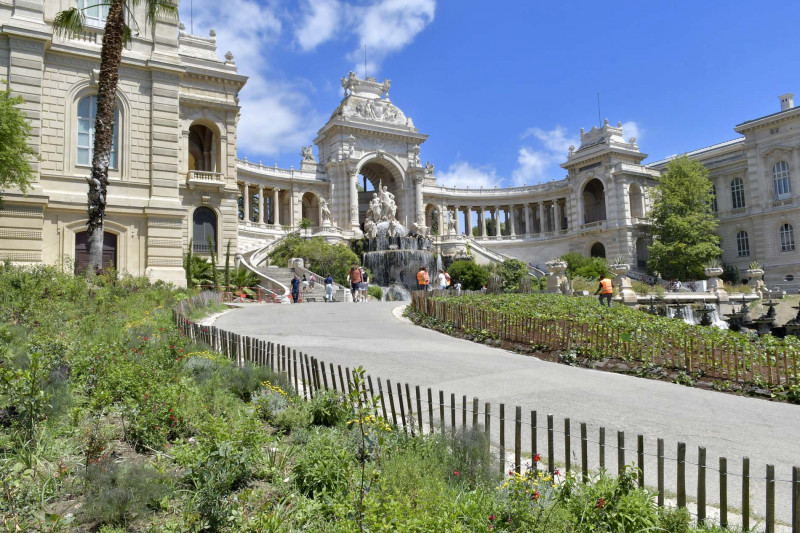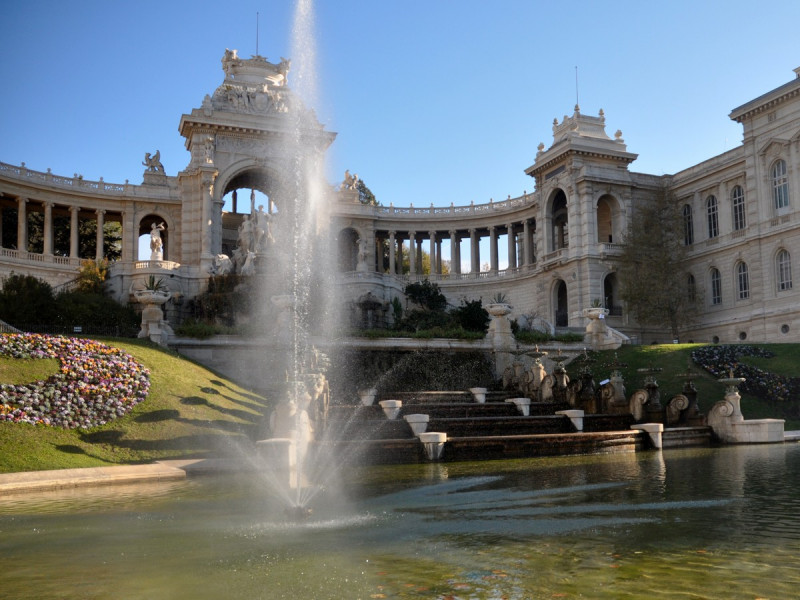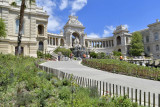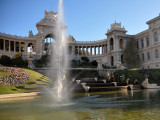Palais Longchamp Park
Park and garden Garden ParkPresentation
Palais Longchamp : under the sign of culture and nature .
In some squares, the playgrounds can still be used but are placed under the responsibility of parents who must ensure that sanitary instructions are respected and, in particular, that the children are physically distanced.
Protected as a Historic Monument, Parc Longchamp, which is currently being reconstructed, has been built up over time through the stratification of different projects, imagined or carried out on the site, since the 19th century.
The Longchamp Park, the Borély Park, the Magalone Garden and the 26th Centenary Park were awarded the "remarkable garden" label by the Ministry of Culture in 2005.
In Marseille, as in all of Provence, water control remained a major problem until the construction of the Marseille canal to supply the city with water from the Durance.
On July 8, 1847, the water arrived on the Longchamp plateau, following the canal traced by the Ponts et Chaussées engineer, Frantz Major de Montricher, transforming at the same time, the Marseilles landscape.
To celebrate this event, the architect Henry Espérandieu conceived in 1862 a large-scale project including a monumental fountain surrounded by two wings, one housing the Museum of Natural History and the other the Museum of Fine Arts. He then designed a double staircase encircling the fountain to access his museums, behind which are three gardens.
The public garden called "du plateau" was inaugurated in 1869, at the same time as the water tower, while the "jardin de l'Observatoire" was created between 1863 and 1864. Under the garden of the plateau, two superimposed rooms were built to collect the waters of the canal of Marseille which were decanted there before being redistributed in the city. These basins, an essential element of the hydraulic system, buried and supported by a forest of pillars, will soon be restored.
Finally, the Zoological Garden, open to the people of Marseille since 1854, illustrates the passion of the Second Empire for exoticism and travel. A victim of public disaffection, the zoo closed in 1987. The cages, now deserted, evoke the great era of the zoo, in which the big cats themselves only had a few square meters to escape their boredom.
Of the three gardens created, only two are open to the public today: the "plateau garden" and the "zoological garden".
The "jardin du plateau", conceived by Espérandieu as a setting for the "Palais Longchamp" and created behind the water tower, was laid out in the French style, in the spirit of Edouard André. The wide, winding paths highlight the sculpted group representing the Durance River and the stalactite-adorned waterfall celebrating the arrival of the Canal in Marseille. The transparency of the central body of the water tower allows a perspective view of the city.
The zoological garden belongs to the current of "picturesque" or "English" gardens integrating a reconstituted nature and giving pride of place to decorative elements. One can still observe a bandstand, some orientalist structures (the giraffe and elephant pavilions and the wild animal cages decorated with turquoise ceramics), rock garden elements (the seal cascade, the aviary and the bear cage) and a "rustic" hut, formerly occupied by ostriches. Other cages are adorned with naïve paintings and feature decorated fences and brick houses.
Protected as a Historic Monument, Parc Longchamp, which is currently being reconstructed, has been built up over time through the stratification of different projects, imagined or carried out on the site, since the 19th century.
The Longchamp Park, the Borély Park, the Magalone Garden and the 26th Centenary Park were awarded the "remarkable garden" label by the Ministry of Culture in 2005.
In Marseille, as in all of Provence, water control remained a major problem until the construction of the Marseille canal to supply the city with water from the Durance.
On July 8, 1847, the water arrived on the Longchamp plateau, following the canal traced by the Ponts et Chaussées engineer, Frantz Major de Montricher, transforming at the same time, the Marseilles landscape.
To celebrate this event, the architect Henry Espérandieu conceived in 1862 a large-scale project including a monumental fountain surrounded by two wings, one housing the Museum of Natural History and the other the Museum of Fine Arts. He then designed a double staircase encircling the fountain to access his museums, behind which are three gardens.
The public garden called "du plateau" was inaugurated in 1869, at the same time as the water tower, while the "jardin de l'Observatoire" was created between 1863 and 1864. Under the garden of the plateau, two superimposed rooms were built to collect the waters of the canal of Marseille which were decanted there before being redistributed in the city. These basins, an essential element of the hydraulic system, buried and supported by a forest of pillars, will soon be restored.
Finally, the Zoological Garden, open to the people of Marseille since 1854, illustrates the passion of the Second Empire for exoticism and travel. A victim of public disaffection, the zoo closed in 1987. The cages, now deserted, evoke the great era of the zoo, in which the big cats themselves only had a few square meters to escape their boredom.
Of the three gardens created, only two are open to the public today: the "plateau garden" and the "zoological garden".
The "jardin du plateau", conceived by Espérandieu as a setting for the "Palais Longchamp" and created behind the water tower, was laid out in the French style, in the spirit of Edouard André. The wide, winding paths highlight the sculpted group representing the Durance River and the stalactite-adorned waterfall celebrating the arrival of the Canal in Marseille. The transparency of the central body of the water tower allows a perspective view of the city.
The zoological garden belongs to the current of "picturesque" or "English" gardens integrating a reconstituted nature and giving pride of place to decorative elements. One can still observe a bandstand, some orientalist structures (the giraffe and elephant pavilions and the wild animal cages decorated with turquoise ceramics), rock garden elements (the seal cascade, the aviary and the bear cage) and a "rustic" hut, formerly occupied by ostriches. Other cages are adorned with naïve paintings and feature decorated fences and brick houses.
Accessible for disabled
Opening period (s)From 01/01 to 31/12, daily.
General information
- Parking :
- Parking nearby
- Price :
- Free
- Services :
- Pets welcome
- Park :
- Calanques National Park
Services, Tours, Activities and entertainment
- Bathroom/toilets :
- Public WC
- Leisure facilities :
- Play area
- Leisure sporting facilities :
- Stadium / Sports ground
Accessibility
- Accessibility criteria for people with reduced mobility :
- Accessible for wheelchairs with assistance
- Accessible for self-propelled wheelchairs
Contact
Palais Longchamp Park
Boulevard du Jardin zoologique
13004
Marseille
Phone : 3013
Tarifs
Free of charge.

FICHE_INFO_SIMPLE_LIBELLE_DESTINATION
Parc Longchamp
Boulevard du Jardin zoologique
13004
Marseille
GPS coordinates
Latitude : 43.304523
Longitude : 5.397377






